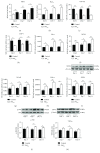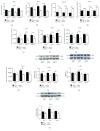The Kidney Injury Induced by Short-Term PM2.5 Exposure and the Prophylactic Treatment of Essential Oils in BALB/c Mice
- PMID: 30151074
- PMCID: PMC6087578
- DOI: 10.1155/2018/9098627
The Kidney Injury Induced by Short-Term PM2.5 Exposure and the Prophylactic Treatment of Essential Oils in BALB/c Mice
Abstract
PM2.5 is well known as a major environmental pollutant; it has been proved to be associated with kidney diseases. The kidney damage involves oxidative stress and/or inflammatory response. NOX4 is a major source of reactive oxygen species (ROS) generation in the kidney, and the excessive generation of ROS is recognized to be responsible for oxidative stress. To elucidate whether short-term PM2.5 exposure could induce kidney damage, we exposed BALB/c mice to PM2.5 intratracheally and measured the biomarkers of kidney injury (KIM-1, cystatin C), oxidative stress (MDA, SOD-1, and HO-1), and inflammatory response (NF-κB, TNF-α). Acute kidney damage and excessive oxidative stress as well as transient inflammatory response were observed after PM2.5 installation. The overexpression of some components of the angiotensin system (RAS) after PM2.5 exposure illustrated that RAS may be involved in PM2.5-induced acute kidney injury. CEOs (compound essential oils) have been widely used because of their antioxidant and anti-inflammation properties. Treatment with CEOs substantially attenuated PM2.5-induced acute kidney injury. The suppression of RAS activation was significant and earlier than the decrease of oxidative stress and inflammatory response after CEOs treatment. We hypothesized that CEOs could attenuate the acute kidney injury by suppressing the RAS activation and subsequently inhibit the oxidative stress and inflammatory response.
Figures






References
-
- Turner M. C., Krewski D., Pope C. A., III, Chen Y., Gapstur S. M., Thun M. J. Long-term ambient fine particulate matter air pollution and lung cancer in a large cohort of never-smokers. American Journal of Respiratory and Critical Care Medicine. 2011;184(12):1374–1381. doi: 10.1164/rccm.201106-1011oc. - DOI - PubMed
-
- Milojevic A., Wilkinson P., Armstrong B., Bhaskaran K., Smeeth L., Hajat S. Short-term effects of air pollution on a range of cardiovascular events in England and Wales: case-crossover analysis of the MINAP database, hospital admissions and mortality. Heart. 2014;100(14):1093–1098. doi: 10.1136/heartjnl-2013-304963. - DOI - PMC - PubMed
MeSH terms
Substances
LinkOut - more resources
Full Text Sources
Other Literature Sources
Miscellaneous

